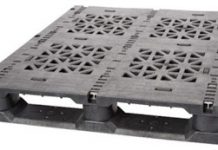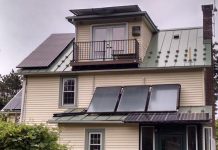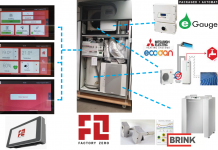Tom Konrad, CFA
PFB Corporation is a manufacturer of energy efficient building materials, including SIPD and ICFs, based on expanded polystyrene. The company’s sales have fallen in response to the housing downturn, but less so than most of the housing industry, despite a strong balance sheet and cash flow. I consider the stock a buy below C$6.
NOTE: I’m taking a break in order to take a trip to California for some vacation and to moderate a panel at the San Francisco Moneyshow. This article was written in January 2010, but I delayed publication for seven months because the company is very thinly traded, and I was still adding to my position. In July and early August, the stock fell decisively below C$6, due to losses caused by the moribund market for new homes in the first half of 2010. I saw these losses as providing the opportunity I needed to complete my planned purchases of this very thinly traded stock.
 When Bill Paul called PFB Corporation (PFB.TO/PRBOF.PK) an “energy efficiency play” whose managers have the “demonstrated ability to control costs (and maintain the regular 6-cent-a-share divided payout) in tough economic times,” he instantly had my attention. Pure energy efficiency companies are rare, and managers’ ability to control costs is priceless. Any energy efficiency stock which has managed to maintain liquidity (not to mention a dividend) in the current downturn is worth a look.
When Bill Paul called PFB Corporation (PFB.TO/PRBOF.PK) an “energy efficiency play” whose managers have the “demonstrated ability to control costs (and maintain the regular 6-cent-a-share divided payout) in tough economic times,” he instantly had my attention. Pure energy efficiency companies are rare, and managers’ ability to control costs is priceless. Any energy efficiency stock which has managed to maintain liquidity (not to mention a dividend) in the current downturn is worth a look.
I look for four things in a stock:
- A good business.
- A strong balance sheet and cash flow that can allow the company to continue executing its business model when external financing is scarce.
- Competent and honest management with both an understanding of the business and a record of straightforwardness with shareholders and analysts.
- A good value for the money.
The Business
 PFB manufactures products based on Expanded Polystyrene (a.k.a. Styrofoam, or EPS,) including Structural Insulated Panels (SIPs) and Insulated Concrete Forms (ICFs) for the green building market. I first heard of both SIPs and ICFs in a course on homebuilding I took in 2003, and I left the class confident that I would use one or the other if I ever designed my own home.
PFB manufactures products based on Expanded Polystyrene (a.k.a. Styrofoam, or EPS,) including Structural Insulated Panels (SIPs) and Insulated Concrete Forms (ICFs) for the green building market. I first heard of both SIPs and ICFs in a course on homebuilding I took in 2003, and I left the class confident that I would use one or the other if I ever designed my own home.
For new buildings, SIPs and ICFs are among the simplest and most practical ways to erect a well-insulated building quickly. SIPs easily achieve high R-Values with minimal air leakage, while ICFs have many of the same advantages as walls, but have the additional advantage of being fireproof and extremely strong.
With a green building code improving the baseline, and green buildings taking a larger market share, PFB’s products are in the right place in the housing industry, even if the housing industry is not the best industry to be in. While neither SIPs nor ICFs are exclusive to PFB, the company has invested in making sure that their products are listed in many local building codes in North America.
I like the business, despite the fact that the market for EPS products, including SIPs and ICFs are competitive, and the company is vulnerable to continued weakness in the North American building industry.
Balance Sheet and Cash Flow
The company carries little debt, which it has reduced slightly since the onset of the financial crisis, despite a decline in revenues. It has strong cash flow from operations and current ratio of current assets to current liabilities. It has a small (relative to the size of the company) pension deficit. This deficit worsened by the 2008 market crash, but it remains small compared to cash flow. Furthermore, the last evaluation of the pension deficit was conducted on March 31, 2009, near the stock market bottom. I anticipate that the next evaluation will show a reduction in the pension deficit due to improved market conditions. Although the company has relatively little debt, it has extended its credit facilities during the year, although these facilities remain mostly unused. This should provide them with an additional cushion in case building industry conditions worsen.
 Profits are sensitive to input costs, which are mostly denominated in dollars, as well as oil and gas prices, which are major components of cost of goods. Declining energy prices in 2009 have meant that the company has been much more profitable in 2009 than in 2008, despite a 16% decline in sales. About 4/5 of PFB’s sales are in Canada, which helped insulate the company from the more severe housing downturn in the United States.
Profits are sensitive to input costs, which are mostly denominated in dollars, as well as oil and gas prices, which are major components of cost of goods. Declining energy prices in 2009 have meant that the company has been much more profitable in 2009 than in 2008, despite a 16% decline in sales. About 4/5 of PFB’s sales are in Canada, which helped insulate the company from the more severe housing downturn in the United States.
My back of the envelope estimate is that the company would be close to break even if energy prices returned to 2008 levels without any increase in sales volume. I don’t expect this scenario to occur, and so expect the company to remain profitable in 2010, with a good chance of improving profitability. Although higher energy prices may hurt the company in the short term, over the long term high energy prices will increase demand for green building products as a share of building materials, which will in turn help PFB.
For US investors, the company’s sensitivity to the dollar is an advantage. PFB’s profits increase with a falling dollar, which means that gains in PFB’s stock price may somewhat offset losses in the investor’s purchasing power that result from a declining dollar, and if the company is hurt by a strong dollar, the US investor will be better able to bear any losses because of his general increase in purchasing power.
Management
With a small company such as PFB with little management coverage, it is often difficult to get an accurate idea of management quality. That said, those indications that I do have are good. One sign I look for is complex financial structures or excessive related party transactions when reading the annual reports. I found both the 2008 annual report and the most recent quarterly report (Q3 2009) commendably straightforward and easy to understand.
I was also pleasantly surprised that although all outstanding employee incentive options are considerably out of the money (weighted average execution price C$8.45) the company has not felt the need to revalue these options downward or issue new options at lower strike prices, despite the decline of the stock price from C$12 in 2006 to C$8 in 2008 to below C$6 today. Option based compensation is charged as an expense against income based on a Black-Scholes valuation at the time of issuance, which, due to the decline in the stock price since options were last issued most likely overstates the value of the options and in turn depresses income.
I recently read Dan Ariely’s Predictabl
y Irrational: The Hidden Forces That Shape Our Decisions. It contains a chapter towards the end on how we actually end up making moral decisions, and it’s rather depressing reading for any of us who want to think the best of our fellow man, any company’s management, or ourselves. But one conclusion he draws is that nearly everyone acts much more responsibly when they’ve recently been thinking about morality, in any form. With this in mind, I think it’s worth noting that PFB displays their corporate Code of Business Conduct and Ethical Policy fairly prominently on the website. Just having such a code does not necessarily mean much, but the fact that they have one puts them a big step ahead of the many small companies that don’t.
Value for Money
The company has a C$0.06 quarterly dividend which I expect it to maintain for the foreseeable future, which translates into a healthy dividend yield of about 4.5% at the C$5.35 price at which I bought most of my shares. Given the uncertain future of the housing industry, I’m uncomfortable predicting future earnings, but I expect the company to be able to survive a sustained downturn, which would improve its competitive position in the industry. If the housing market remains stable or recovers slightly without outsized increases in oil and natural gas prices, the company should be able to maintain earnings of C$0.30 to C$0.45 per share, giving a P/E ratio in the 12-20 range, and allow the company to maintain a share price in the $4-$6 range. Rosier scenarios should produce large increases in profits, which ranged from C$0.60 to C$0.92 per share during the 2005-7 housing boom. Those levels of profitability need not require a return to the housing boom since a growing market share for green building is likely to increase the market of PFB’s products even in a flat housing market.
Liquidity
The biggest negative for PFB is the company’s liquidity. Less than $10,000 worth of shares trade on a typical day. This means that even one investor with a decent amount of money to invest could significantly raise the price of the stock (or drop it when selling.) Because of this, I decided to leave PFB out of my Ten Green Energy Stocks for 2010, even though I think it’s a better value (at C$6 or less) than the three energy efficiency stocks in the list. The problem is, very few readers will be able to buy this stock at that price, and my annual list is so widely followed that most readers would have ended up overpaying.
I decided to sneak this article in with a bit less fanfare, to let my most loyal readers get the first chance. But be careful! With a stock this thinly traded, you should almost certainly use limit orders to avoid overpaying.
Conclusion
Positives: Energy Efficiency business. Profitable, decent cash flow, minimal debt. Reasonable valuation. C$0.24 annual dividend (4% at C$6).
Negatives: Very thinly traded. Housing industry.
Recommendation: Buy below C$6.00, unless homebuilding gets even worse than it is now.
DISCLOSURE: Long PFB.TO/PFBOF.PK
DISCLAIMER: The information and trades provided here are for informational purposes only and are not a solicitation to buy or sell any of these securities. Investing involves substantial risk and you should evaluate your own risk levels before you make any investment. Past results are not an indication of future performance. Please take the time to read the full disclaimer here.









Thanks for sharing this Tom! I’m a believer in energy efficiency and I got in today on PFBOF for $5.65. (D_lane)
It’s nice to find an EE stock with a nice dividend. Speaking of which, I just bought a little more Waterfurnace at US$23.75. All hedged, of course.